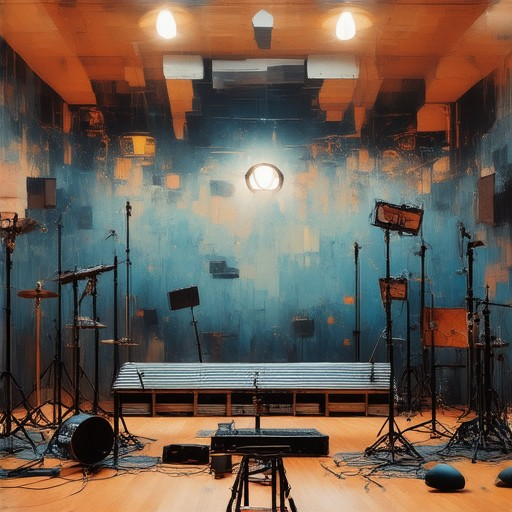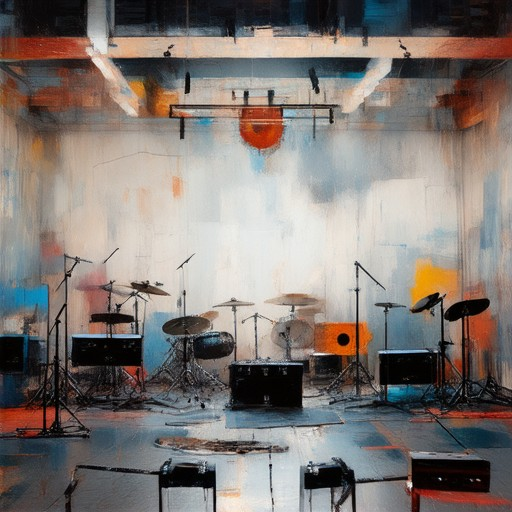Are you looking to optimize your rehearsal space setup to ensure peak performance and a successful outcome? A well-organized and strategically designed rehearsal space can significantly enhance your preparation process, allowing you to focus on delivering your best work. Whether you’re a solo performer or part of a larger group, the right setup is crucial for achieving your goals. With the right rehearsal space setup tips, you can streamline your workflow, improve communication, and create an environment that fosters creativity and collaboration. From acoustics to layout and storage solutions, this guide will walk you through the essential steps to transform your rehearsal space into a highly functional hub. Don’t miss out on the opportunity to elevate your practice sessions and take your performance to the next level.
Key Takeaways
- Acoustic Optimization: Enhance sound quality with acoustic panels and thorough checks to reduce echoes and improve vocal clarity.
- Lighting Setup: Ensure effective illumination and ambiance with a mix of stage and overhead lights, prioritizing LED durability.
- Space Preparation: Accurately measure dimensions and clearly mark performance areas to ensure equipment fit.
- Stage Management: Assign specific roles and conduct full run-throughs to streamline performance execution.
- Audience Interaction: Tailor arrangements based on venue capacity to optimize viewer experience.
- Comfort and Safety: Provide essential resources and maintain a hazard-free environment with clear emergency exits.
- Strategic Location: Select a quiet, accessible space with proximity to transport and necessary facilities.
- Efficient Storage: Implement organized solutions like shelves and cabinets for secure equipment storage.
- Power Solutions: Ensure reliable and safe electrical support with multiple power strips and proper cord management.
- Budget Planning: Begin with essentials like location and lighting, then consider optional upgrades.
- Regulatory Compliance: Adhere to health and safety standards to create a secure rehearsal environment.

How to Effectively Set Up a Rehearsal Space
Setting up an effective rehearsal space requires careful consideration of several factors to ensure it meets your needs while minimizing distractions and discomfort. Here’s a step-by-step guide to help you create the perfect rehearsal environment:
1. Select the Right Location
Choose a room that offers adequate space for your musical equipment, instruments, and seating arrangements. Ensure the location is quiet and free from distractions. Consider the availability of power outlets and natural light to enhance comfort and functionality.
2. Optimize Acoustics
A poor acoustic environment can hinder your performance and practice sessions. Use acoustic panels or foam tiles to absorb unwanted noise. Position instruments and voices away from hard surfaces like walls and windows to reduce echo and feedback.
3. Ensure Comfortable Lighting
Install flexible lighting options such as LED lights or track lighting to adjust the brightness according to your needs. Make sure the lighting is evenly distributed to avoid shadows and allow everyone to see clearly during rehearsals.
4. Arrange Seating and Furniture
Set up comfortable chairs or benches for musicians and audience members. Create separate areas for seating, standing, and instrument placement to facilitate movement and streamline the rehearsal process.
5. Organize Storage Solutions
Implement shelving or cabinets to store music stands, cases, and other essentials. Keep the space tidy to maintain a productive environment and easy access to materials.
6. Maintain Proper Ventilation
Ensure the room has fresh air circulation to keep the space comfortable during long rehearsals. Open windows or use fans to regulate airflow and prevent stuffiness.
7. Prioritize Safety
Check for fire exits, emergency exits, and ensure the area is free from tripping hazards. Keep flammable materials away from heat sources and consider installing smoke detectors if needed.
8. Add Practical Extras
Incorporate mirrors to help musicians check their outfits or stage presence. Install a PA system for live performances and organize cables neatly to avoid tangling.
9. Design a Functional Layout
Plan the layout to maximize space utilization. Divide the area into zones for standing, sitting, and instrument storage. Ensure there’s enough room for movement and easy access to all items.
10. Tech Setup and Multi-Purpose Use
Set up a dedicated area for mixing and sound engineering if required. Use the space for additional purposes like hosting small meetings or workshops to increase its versatility.
By following these steps, you’ll create a rehearsal space that’s not only functional but also enjoyable and inspiring for your musical endeavors. Remember to regularly update and maintain the space to keep it optimized for your needs!
Best Rehearsal Space Setup Tips
Setting up the perfect rehearsal space is crucial for maximizing efficiency and comfort during your musical practices. Here are our top tips to create an ideal environment:
- Acoustics Management
- Invest in soundproofing panels or acoustic foam to minimize noise leakage and echo effects.
- Position your monitors or speakers strategically to ensure balanced sound distribution without feedback issues.
- Avoid reflective surfaces like glass or mirrors that can distort sound waves.
- Ensure bright yet controlled lighting to prevent eye strain and maintain visibility during performances.
- Use a combination of overhead lights and stage lights to create a well-distributed illumination.
- Adjust the color temperature to match your practice needs, typically around 3000K to 5500K Kelvin range.
- Choose adjustable chairs or stools to maintain proper posture and comfort during long sessions.
- Arrange instruments and equipment within easy reach to reduce strain and movement.
- Include breaks or standing areas to alleviate fatigue and promote circulation.
- Install shelving or cabinets to store music stands, cases, and accessories neatly.
- Label all items for quick access and avoid misplaced items during rehearsals.
- Keep the space clean by regularly organizing and tidying up after each session.
- Set up power strips and extension cords safely near your main area to minimize cord clutter.
- Use cable management tools like raceways or Velcro ties to keep wires organized.
- Position your main PA system or recording devices centrally for optimal coverage and clarity.
- Maintain a moderate temperature between 68°F to 72°F (20°C to 22°C) to keep energy levels high.
- Consider air quality by using plants or air purifiers to create a fresh environment.
- Ensure minimal distractions by positioning your rehearsal space away from busy areas.
By implementing these tips, you’ll create a rehearsal space that is functional, comfortable, and conducive to achieving your full potential during every practice session. Remember to explore additional resources like our music gear guide and artist development program for further enhancements.

What Are the Best Rehearsal Space Setup Tips for Success?
To ensure a successful performance, your rehearsal space needs to be optimized for both functionality and creativity. Here are expert-recommended tips to maximize your rehearsal space setup:
- Optimize Acoustics :
- Use acoustic panels and bass traps to control sound reflections and reduce echo.
- Position instruments and voices away from hard surfaces to minimize feedback.
- Experiment with furniture arrangement to enhance sound distribution.
- Learn more about acoustic solutions .
- Arrange Lighting Thoughtfully :
- Set up a combination of stage lights and audience lights to mimic live conditions.
- Use dimmers and color gels to create the right mood during rehearsals.
- Position lights strategically to avoid shadows on performers and instruments.
- Discover effective lighting configurations .
- Place Equipment Strategically :
- Keep all essential gear within easy reach but organized to prevent clutter.
- Use cable management systems to keep wires tidy and safe.
- Store props and staging materials in designated areas to streamline setup.
- Explore equipment management tips .
- Ensure Comfort for Everyone :
- Provide ergonomic chairs, standing platforms, and height-adjustable tables.
- Offer water and snack stations to keep energy levels high.
- Maintain a comfortable temperature with adjustable heating and cooling systems.
- Find ways to enhance comfort .
- Create a Focal Point :
- Use a large mirror or reflective surface to help musicians visualize their performance.
- Position a screen or backdrop to simulate live concert settings.
- Maximize visual aids .
- Test the Space Beforehand :
- Conduct a full-run-through of your setlist to identify potential issues.
- Adjust speaker positioning based on sound quality during rehearsals.
- Evaluate your space effectively .
By implementing these tips, you’ll create a rehearsal environment that enhances focus, reduces stress, and ensures your performance is polished and memorable.

Rehearsal Space Setup Tips for Success
Setting up the rehearsal space correctly is essential for a smooth and successful performance. Here are the most important tips to ensure your preparation is spot on:
- Acoustics Check:** Before starting, inspect the sound quality of the space. Use instruments or voices to test echo and reverberation. Bring a sound engineer if possible to fine-tune the environment.
- Lighting Setup:** Ensure all stage lights and audience lights work properly. Test dimmers and switches beforehand. Have backup lights ready for emergencies.
- Space Measurement:** Measure the dimensions of the room to confirm it fits all equipment and setups. Mark the designated performance area clearly.
- Stage Management:** Assign specific roles and areas for each performer. Conduct a full run-through of the setlist to ensure everyone knows their positions.
- Audience Interaction Plan:** Decide how the audience will interact with the performance, whether through seating arrangements or standing arrangements, based on the venue size.
- Comfort and Safety:** Ensure performers have access to water, shade, and comfortable seating. Check for tripping hazards and ensure emergency exits are accessible.
Essential Steps to Set Up a Rehearsal Space
To effectively set up a rehearsal space, follow these organized steps:
- Location Selection : Choose a quiet, spacious area with enough room for band members and equipment. Consider factors like proximity to public transportation and availability of utilities.
- Acoustic Treatment : Implement soundproofing measures such as acoustic panels to reduce noise levels and enhance vocal clarity.
- Lighting Setup : Install a combination of stage lights and overhead lights, preferably LED for durability and energy efficiency.
- Seating and Stage : Arrange comfortable seating for band members and set up a small stage for performances.
- Storage Solutions : Utilize shelves for instrument storage and cabinets for cable management to keep the space organized.
- Power Outlets : Ensure there are ample electrical outlets to support lighting, PA systems, and other equipment.
- Safety Measures : Label all cords to prevent accidents and ensure a safe layout to avoid trip hazards.
- Budget Planning : Start with essential elements like location and lighting, then consider optional upgrades like soundproofing and advanced storage solutions.
- Regulatory Compliance : Check local regulations to ensure the space meets health and safety standards.
By following these steps, you can create a functional and efficient rehearsal space tailored to your needs.

Best Rehearsal Space Setup Tips
Setting up the perfect rehearsal space involves careful planning and organization to maximize efficiency and comfort. Here are the top tips to create an ideal environment:
- Lighting Setup:** Ensure adequate lighting for visibility and mood. Use a combination of overhead lights and stage lights to illuminate performers and instruments effectively.
- Acoustic Treatment:** Install acoustic panels or bass traps to minimize echo and feedback during rehearsals. This ensures clearer sound quality and better communication among band members.
- Seating and Spacing:** Provide comfortable seating for all members, including chairs, stools, or benches. Ensure enough space for instruments, cases, and props to avoid clutter.
- Power Solutions:** Set up multiple power strips with surge protectors to accommodate all electronic devices. Use extension cords safely to reach outlets in different areas of the space.
- Stage Setup:** Create a functional stage area with stands, backdrops, and monitor screens. Consider using modular stages for easy rearrangement during rehearsals.
- Sound System:** Invest in a reliable PA system and monitor setup to ensure everyone can hear clearly. Position speakers and monitors strategically based on the room layout.
- Organization and Storage:** Designate areas for instrument storage, prop organization, and equipment management. Use shelves, cabinets, or hooks to keep everything accessible and tidy.
- Safety Measures:** Keep fire extinguishers, first aid kits, and emergency exit signs visible. Plan escape routes and ensure the space is free from tripping hazards.
- Comfort and Ergonomics:** Use ergonomic chairs and adjustable stands to reduce fatigue during long rehearsals. Ensure all equipment is within easy reach to minimize strain.
By following these tips, you can create a rehearsal space that is both functional and inspiring, allowing you to focus on your performance and creativity.



0 Comments